CNG And LPG Vehicle Market Size and Trends
The CNG and LPG vehicle market is estimated to be valued at USD 6.00 Bn in 2025 and is expected to reach USD 13.78 Bn by 2032, growing at a compound annual growth rate (CAGR) of 12.6% from 2025 to 2032.
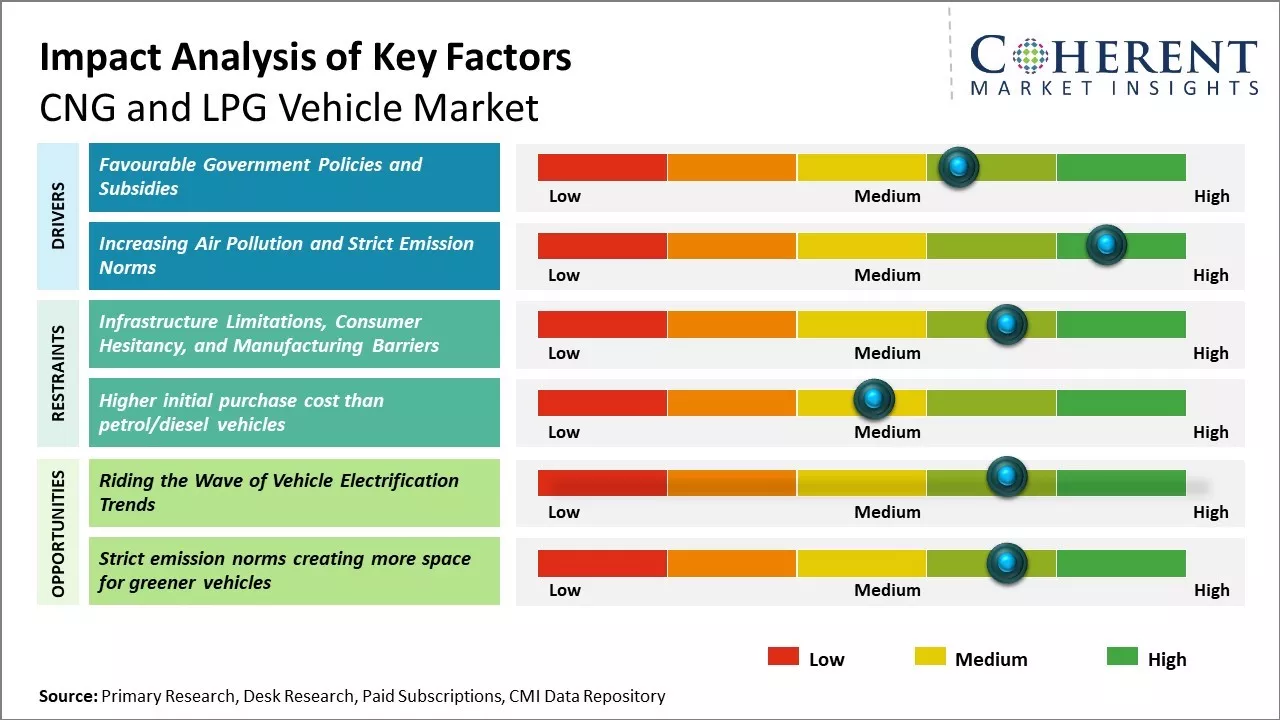
Discover market dynamics shaping the industry: Download Free Sample
The market is expected to witness significant growth during the forecast period. Stringent emission norms by governments across the globe regarding vehicular emissions and rising fuel prices are encouraging consumers to switch to cheaper and cleaner alternatives such as Compressed natural gas (CNG) and Liquefied petroleum gas (LPG). Also, incentives by various governments for the adoption of CNG/LPG vehicles along with growing focus of auto makers on introducing new CNG/LPG variants of their popular vehicles are some of the key factors that are anticipated to drive the demand for CNG and LPG vehicles in the coming years. However, high investment cost for the conversion of vehicles and lack of fuelling infrastructure may hinder the market growth to some extent.
Favorable Government Policies and Subsidies
Favorable government policies and initiatives taken by the government to promote CNG and LPG vehicles have been major drivers for the growth of the market. Many countries across the globe are putting stringent norms on carbon emission from vehicles to curb the rising pollution levels. At the same time, the depleting crude oil reserves and fluctuation in crude oil prices makes these countries explore alternate fuel options. It is here that the governments see CNG and LPG as viable clean green fuel alternatives to gasoline and diesel.
For instance, over the past few years, governments have introduced various schemes to make CNG and LPG vehicles more affordable for the common man and also incentivize their adoption. Many nations offer sizable subsidies on the purchase of new CNG/LPG vehicles. For example, the Indian government provides a subsidy of USD 181-362 per CNG vehicle depending on the vehicle type. Such subsidies have made CNG cars more affordable and appealing for many lower-middle class families. Some countries also give tax rebates and lower road tax for CNG/LPG cars.
Market Concentration and Competitive Landscape
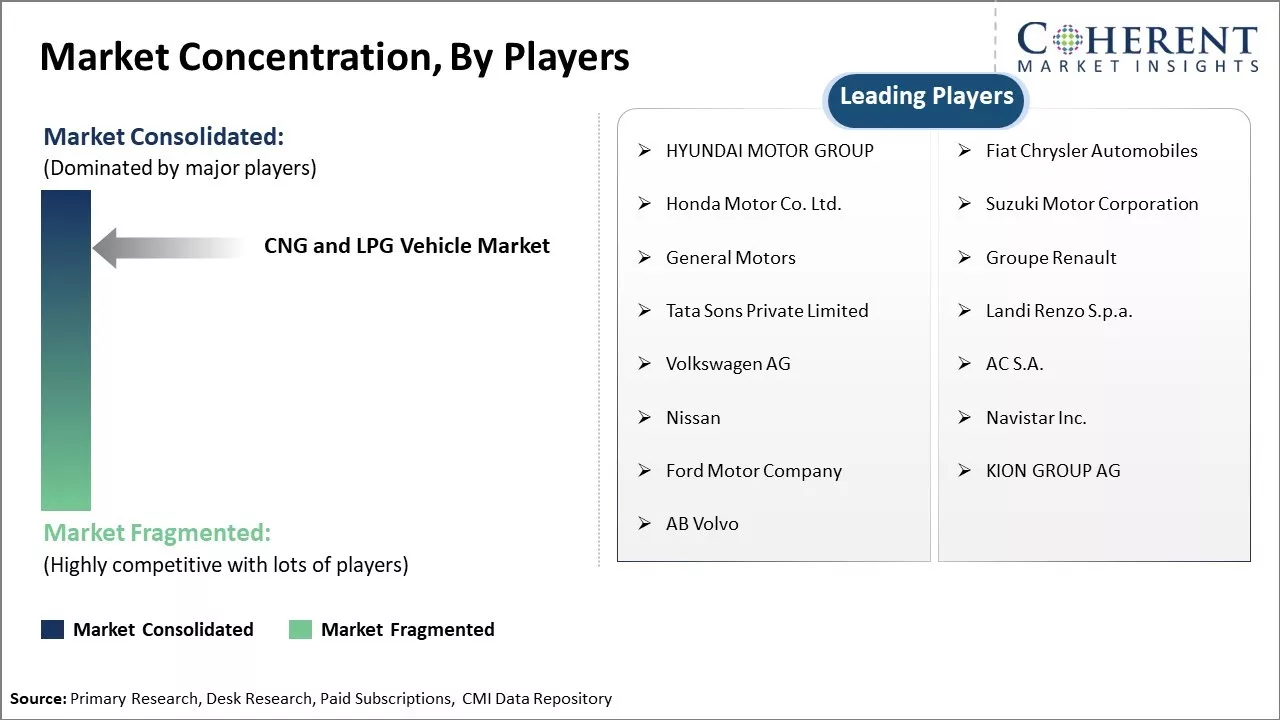
Get actionable strategies to beat competition: Download Free Sample
Increasing Air Pollution and Strict Emission NormsAir pollution has become a major concern around the world with cities witnessing alarming levels of toxic emissions in the air. The transportation sector is identified as one of the major contributors to this problem, especially vehicles powered by gasoline and diesel.
Moreover, the demand for vehicles running on alternative fuels is rising due to strict emission regulations, higher fuel costs, and increased customer awareness. In 2021, the sales of Compressed Natural Gas (CNG) vehicles in India surged to 163,696 units, a significant jump from 41,572 units in 2020.
As per the International Monetary Fund (IMF), oil prices increased by 12% in 2021 compared to the previous year. This uptick was driven by the growing demand for oil as countries reopened and their economies began recovering from the impact of the receding COVID-19 pandemic.
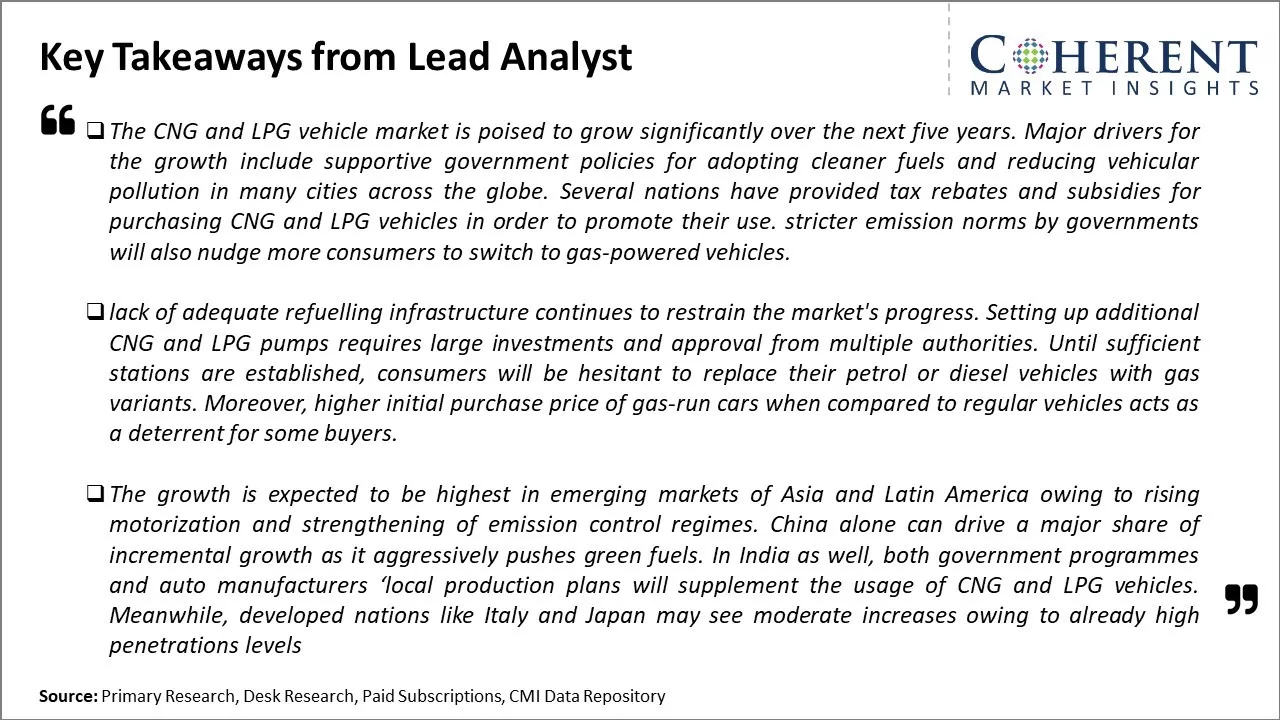
To learn more about this report, Download Free Sample
Market Challenges: Infrastructure Limitations, Consumer Hesitancy, and Manufacturing BarriersThe CNG and LPG vehicle market faces several challenges. Customers are hesitant to purchase alternative fuel vehicles due to concerns over limited refuelling infrastructure and the higher initial costs compared to gasoline or diesel vehicles. Educating consumers about the long-term savings potential and encouraging more gas station owners to offer CNG/LPG pumps will take significant effort and investment. Automakers also must overcome barriers to designing dual-fuelled models and expanding production volumes enough to drive down costs. Stricter emission standards worldwide will further drive-up costs of compliance for manufacturers.
Market Opportunities: Riding the Wave of Vehicle Electrification Trends
High fuel prices make the total cost of ownership figures for CNG and LPG vehicles increasingly competitive. A growing emphasis on reducing emissions and vehicle electrification trends from both consumers and regulators provides a favorable policy environment. New technologies are constantly striving to close the price gap.
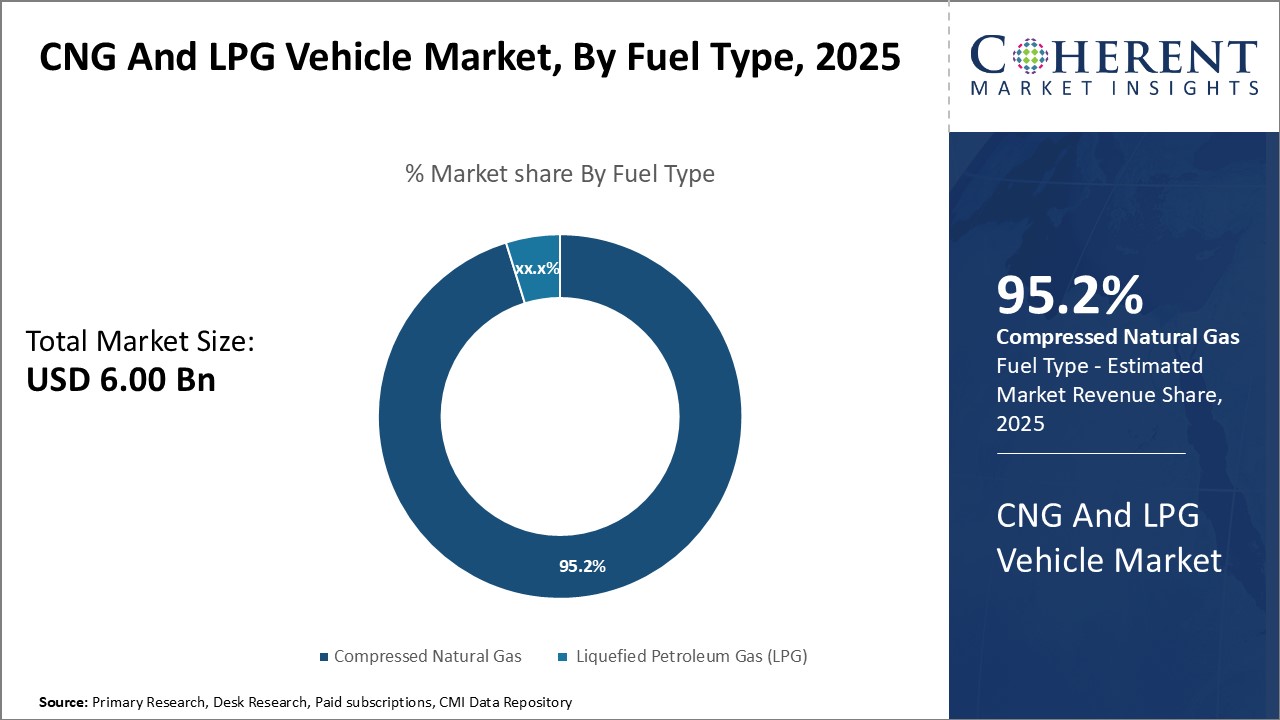
Discover high revenue pocket segments and roadmap to it: Download Free Sample
Insights, By Fuel Type - Compressed Natural Gas Drives the Fuel Type SegmentCompressed Natural Gas (CNG) is estimated to hold the highest share of 95.2% in 2025 in the market owing to its cost effectiveness and environmental friendliness relative to gasoline and diesel. CNG vehicles offer significant savings at the pump as natural gas is currently priced nearly 40-50% lower than an equivalent amount of gasoline. With fluctuating crude oil prices pushing petrol and diesel costs higher, consumers are increasingly attracted to CNG for its stable and affordable fuelling option. This factor has significantly boosted adoption of new CNG vehicles as well as conversions of existing gasoline models.
Another key driver is CNG's eco-friendly status. It produces 25-30% lower greenhouse gas emissions than diesel or petrol. With both public and private sector initiatives promoting 'green' transportation to curb environmental pollution in heavily congested cities, CNG vehicles are being incentivized through subsidies and tax exemptions. Original equipment manufacturers have responded by expanding their CNG-compatible vehicle ranges. Rising environmental awareness among urban consumers concerned about air quality has further augmented CNG vehicle sales.
Government policies also support CNG infrastructure growth. Efforts to ramp up the CNG station network through public-private partnerships have improved fuel availability beyond key metro regions. Meanwhile, regulations mandating installation of CNG dispensers at petrol pumps mean drivers face less range anxiety. Combined with lower operating costs, the improving fuel supply has encouraged both commercial and private investment in CNG mobility options over time.
The cost and environmental benefits of CNG have increased its penetration among commercial fleet owners as well. Public transport authorities are replacing aging buses with newer CNG models. Goods carriers are also gravitating toward CNG due to its significantly lower total cost of ownership relative to diesel. This commercial usage has boosted industrial demand for CNG vehicles and components. Overall, favorable economics coupled with policy pushes make CNG the dominant fuel type driving the market share. The demand for CNG and LPG vehicles is driven by the growing emphasis on reducing emissions, lowering fuel costs, and increasing energy efficiency. Governments and businesses are increasingly adopting these vehicles to meet environmental goals and take advantage of the economic benefits associated with alternative fuels.
Insights, By Vehicle Type - Passenger Vehicles Lead the Vehicle Type Segment
The passenger vehicle segment is estimated to hold the highest share of 83.5% in 2025 in the CNG and LPG vehicle market. Changing consumer preferences towards family transportation underlines this segment's prominence. Rapid urbanization and improving economic conditions have boosted the sedan and Sports Utility Vehicles demand for commute, school runs, and weekend getaways.
Manufacturers catering to this rising passenger mobility have launched extensive CNG-powered model lines. Options range from entry-level A and B segment cars to larger SUVs suited for city and highway driving alike. Original Equipment Manufacturers focus on delivering comparable performance to gasoline variants has enhanced CNG's user friendliness in private vehicles. Features like powerful yet frugal engines paired with automatic transmission aid mass adoption.
Affordable acquisition and running costs make CNG attractive for drivers' personal transport needs. Lower maintenance and insurance rates compared to diesel further build the value proposition. Tax benefits extend the ownership cost savings. As more households embrace CNG cars for convenience and pocket-friendly ownership, the segment drives significant market velocity.
Evolving lifestyles demanding advanced mobility solutions also impact CNG uptake. Multi-purpose vehicles catering to small families dominate segment volumes with versatile designs. Progressive changes like these continue propelling passenger vehicles as a major demand contributor to the fuel's ongoing commercialization. Investments into developing recreational CNG vehicles will likely maintain this segment's market primacy going forward.
Regional Insights
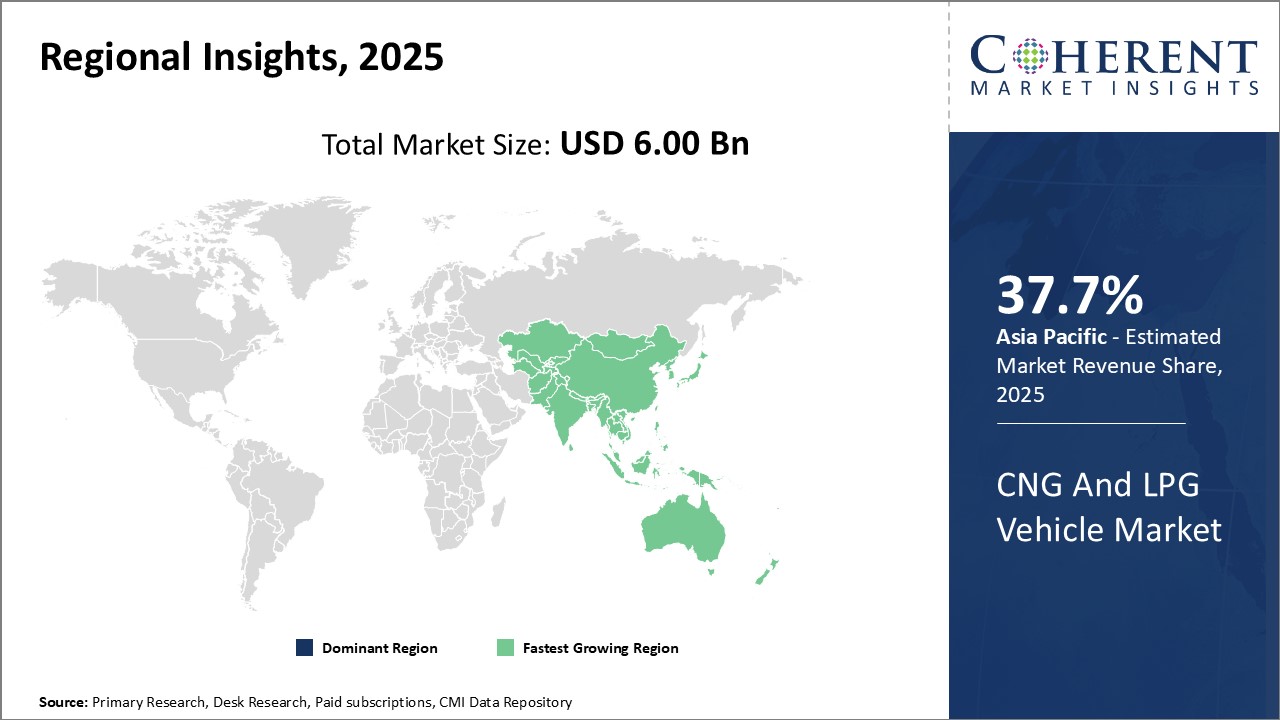
Need a Different Region or Segment? Download Free Sample
The Asia Pacific region, led by India and Pakistan, will dominated the global CNG and LPG vehicle market with the market share by 37.7% in 2025. With rising fuel prices and deteriorating air quality in major cities, both countries have strongly promoted the use of cleaner alternate fuels like CNG and LPG in the transportation sector over the last decade. India, in particular, has one of the largest CNG vehicle fleets in the world with over 5 million vehicles currently running on CNG. This is bolstered by a widespread CNG refuelling infrastructure across major cities with over 3500 stations. Leading auto makers have also introduced popular CNG variants of best-selling models to capture this growing demand. The supportive government policies like fuel subsidies and tax benefits on CNG vehicles have further driven their adoption in the commercial segment.
The Asia Pacific region has emerged as the fastest growing market for CNG and LPG vehicles globally. Countries like Indonesia, Thailand, and Vietnam have seen tremendous growth in their vehicle in recent years due to rising incomes. While personal vehicles still mostly run-on gasoline, the commercial transportation sector is rapidly shifting towards CNG and LPG due to their lower operating costs. This is evident from the increasing number of CNG/LPG powered buses, taxis and delivery vans plying on the roads of major ASEAN cities. Local auto manufacturers have recognized this opportunity and are aggressively promoting eco-friendly models compatible with these alternate fuels. The governments of ASEAN nations are also incentivizing this shift by expanding the refuelling infrastructure and offering purchase incentives on CNG/LPG vehicles. This is expected to boost their regional market share over the coming years.
Market Report Scope
Global CNG and LPG Vehicle Market Report Coverage
| Report Coverage | Details | ||
|---|---|---|---|
| Base Year: | 2024 | Market Size in 2025: | USD 6.00 Bn |
| Historical Data for: | 2020 To 2024 | Forecast Period: | 2025 To 2032 |
| Forecast Period 2025 to 2032 CAGR: | 12.6% | 2032 Value Projection: | USD 13.78 Bn |
| Geographies covered: |
|
||
| Segments covered: |
|
||
| Companies covered: |
HYUNDAI MOTOR GROUP, Fiat Chrysler Automobiles, Honda Motor Co. Ltd., Suzuki Motor Corporation, General Motors, Groupe Renault, Tata Sons Private Limited, Landi Renzo S.p.a., Volkswagen AG, AC S.A., Nissan, Navistar Inc., Ford Motor Company, KION GROUP AG, and AB Volvo |
||
| Growth Drivers: |
|
||
| Restraints & Challenges: |
|
||
Uncover macros and micros vetted on 75+ parameters: Get instant access to report
CNG And LPG Vehicle Industry News
- In May 2023, the European Council officially approved updated regulations mandating that only new 100% electric and hydrogen fuel cell vehicles can be sold in the European market from 2035, both for individual and commercial use. The sale of petrol, diesel, E85, LPG, CNG, and various hybrids, including rechargeable ones, will be banned. This decision will notably impact a sector employing 12.5 million people in Europe, including around 400,000 direct jobs in France.
- In March 2023, HAM Group inaugurated a new liquefied natural gas (LNG) and compressed natural gas (CNG) service station in Benavente, Zamora, located at Caada Berciana 9A. The strategic location near the A-6 (Northwest route), one of Spain's major radial highways, and the N-630, one of the country's longest national highways, enhances accessibility and convenience for customers.
- In March 2022, Anhui Ankai Automobile Co. from China successfully shipped 800 CNG buses to Mexico as part of the Xinhua Silk Route Initiative, strengthening collaboration between China and Mexico. These buses are designated for public transportation services in the city of Monterrey.
- In November 2022, Toyota Kirloskar Motor Pvt. Ltd., an India-based joint venture of Toyota Motor Corp., introduced the Compressed Natural Gas (CNG) variant of their high-end hatchback, the Toyota Glanza, to the Indian market
*Definition: The CNG and LPG vehicle market caters to consumers looking for an affordable and environment-friendly alternative to gasoline vehicles. This market offers vehicles that can run on compressed natural gas (CNG) or liquefied petroleum gas (LPG), both of which are cheaper fuels compared to petrol or diesel. Product offerings include factory-fitted CNG/LPG kits that allow existing vehicles to switch fuels, as well as models designed exclusively to run on CNG or LPG.
Market Segmentation
- Fuel Type Insights (Revenue, USD Bn, 2020 - 2032)
- Compressed Natural Gas (CNG)
- Liquefied Petroleum Gas (LPG)
- Vehicle Type Insights (Revenue, USD Bn, 2020 - 2032)
- Passenger Vehicles
- Hatchback
- Sedan
- Sports Utility Vehicle (SUV)
- Multi Utility Vehicle (MUV)
- Commercial Vehicles
- Light Commercial Vehicle
- Heavy Commercial Vehicle
- Passenger Vehicles
- Regional Insights (Revenue, USD Bn, 2020 - 2032)
- North America
- U.S.
- Canada
- Latin America
- Brazil
- Argentina
- Mexico
- Rest of Latin America
- Europe
- Germany
- U.K.
- Spain
- France
- Italy
- Russia
- Rest of Europe
- Asia Pacific
- China
- India
- Japan
- Australia
- South Korea
- ASEAN
- Rest of Asia Pacific
- Middle East
- GCC Countries
- South Africa
- Israel
- Rest of Middle East
- North America
- Key Players Insights
- HYUNDAI MOTOR GROUP
- Fiat Chrysler Automobiles
- Honda Motor Co. Ltd.
- Suzuki Motor Corporation
- General Motors
- Groupe Renault
- Tata Sons Private Limited
- Landi Renzo S.p.a.
- Volkswagen AG
- AC S.A.
- Nissan
- Navistar Inc.
- Ford Motor Company
- KION GROUP AG
- AB Volvo
Share
Share
About Author
Ameya Thakkar is a seasoned management consultant with 9+ years of experience optimizing operations and driving growth for companies in the automotive and transportation sector. As a senior consultant at CMI, Ameya has led strategic initiatives that have delivered over $50M in cost savings and revenue gains for clients. Ameya specializes in supply chain optimization, process re-engineering, and identification of deep revenue pockets. He has deep expertise in the automotive industry, having worked with major OEMs and suppliers on complex challenges such as supplier analysis, demand analysis, competitive analysis, and Industry 4.0 implementation.
Missing comfort of reading report in your local language? Find your preferred language :
Transform your Strategy with Exclusive Trending Reports :
Frequently Asked Questions
EXISTING CLIENTELE
Joining thousands of companies around the world committed to making the Excellent Business Solutions.
View All Our Clients
